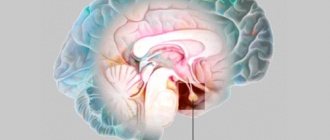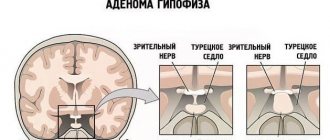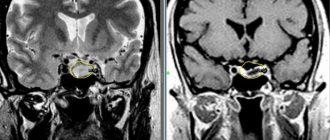During the occurrence of pituitary tumors, symptoms in women may not appear for a long time, which is why the pathology is diagnosed already at an advanced stage. Later, disorders of secondary sexual characteristics, hormonal disruptions and other abnormalities may occur. If you suspect an adenoma in the tissues of the brain, namely in the pituitary gland, you can find out in more detail what it is if you familiarize yourself with the nature and causes of development, as well as methods of treating hormone-producing formations. Neoplasms are most often diagnosed in women over the age of fifty, but can occur even in children.
The pituitary gland is an appendage of the brain responsible for the production of hormones necessary for the proper functioning of all body systems. The pituitary gland accounts for approximately fifteen percent of all brain tumors, with the majority of cases being benign adenoma. Despite this, diseases of the pituitary gland require surgical removal of the tumor and correction of the woman’s condition with hormonal therapy.
Causes
Despite many years of research into the development of tumors in the pituitary gland in women and men, the exact causes of tumors have not yet been clarified. But certain things have been established that can lead to the formation of tumors, that is, they are predisposing factors:
- infection of the nervous system;
- history of TBI;
- heredity and genetic predisposition;
- presence of chronic sinusitis;
- uncontrolled use of hormonal medications, in particular contraceptives (oral and intrauterine).
There is also a possibility that the proliferation of atypical pituitary cells may be triggered by insufficiently productive functionality of the peripheral glands of the endocrine system. The development of tumors is also promoted by excessive production of hypothalamic hormones. In children, congenital adenomas are usually detected, the development of which is associated with a hereditary factor or intrauterine anomalies. Exposure to unfavorable factors on the fetus during pregnancy can cause neoplasms of the pituitary gland in the child.
Structure and functions of the pituitary gland
The pituitary gland is a part of the brain that is part of the endocrine system and produces hormones that affect growth, reproduction and metabolism.
The pituitary gland is a small part of the brain weighing about 500 mg. This organ is the central organ of the endocrine system and produces hormones that affect growth, reproductive function and metabolism.
Consists of 3 main parts:
- The anterior lobe of the pituitary gland (the largest, accounts for up to 80%) of its volume.
- Intermediate (middle) lobe.
- Posterior lobe.
The anterior and middle lobes are combined into the adenohypophysis, and the posterior lobe is called the neurohypophysis.
Major hormones secreted by the pituitary gland
The anterior lobe (adenohypophysis) produces the following hormones:
- Thyroid-stimulating hormone – controls the functioning of the thyroid gland.
- Adrenocorticotropic hormone - monitors the functioning of the adrenal glands.
- Somatotropic hormone - is responsible for the growth of the body, the production of protein in cells, the formation of glucose and the breakdown of fats.
- Follicle-stimulating hormone - stimulates the maturation of follicles in the ovaries.
- Luteinizing hormone is responsible for regulating the lactation process.
Average share:
- Melanostimulating hormones that regulate pigment metabolism (they are also believed to be involved in the regulation of blood pressure, memory processes, as well as in cell growth, immune reactions, cell division, and the functioning of the stomach and intestines).
- Other substances whose functions are not fully understood.
Posterior lobe:
- Antidiuretic hormone - is responsible for the level of blood pressure, as well as the amount of urine excreted by the kidneys.
- Oxytocin.
- Other hormones, for example: mesotocin, isotocin, valitocin, etc.
All lobes of the pituitary gland are closely connected with the hypothalamus, which controls the activity of the pituitary gland with the help of releasing hormones.
Classification
Pathology is classified based on the size of the tumor, its location and functionality. First of all, benign and malignant neoplasms are distinguished. Based on size, the following types of pituitary adenoma are distinguished:
- microadenomas - size does not exceed ten millimeters;
- macroadenomas - the diameter of the adenoma is more than ten millimeters.
Considering the exact localization of the tumor in the gland, there are tumors of the neurohypophysis and adenohypophysis. A pituitary tumor can extend beyond the boundaries of the sella turcica (endosellar) or be located within it (intrasellar). Neoplasms that form in the pituitary gland can be hormonally active or inactive. In seventy-five percent of cases, active pituitary tumors producing one or another hormone are diagnosed. Hormonally active ones include:
- somatotropinomas;
- prolactinomas;
- adenocorticotropinomas;
- thyrotropinomas.
We recommend reading Hodgkin's lymphoma - stages, causes, prognosis
The most common from this list are prolactinomas and somatotropinomas, that is, neoplasms that promote the production of growth hormone and prolactin. The emergence of neoplasms capable of producing one or more different hormones can lead to diseases such as Cushing's disease, acromegaly, and gigantism.
Benign
With benign tumors, development occurs very slowly, and the tumor has virtually no effect on healthy cells. A large benign neoplasm can put pressure on neighboring structures,
Malignant
Malignant neoplasms that form in the pituitary gland are characterized by rapid growth with the penetration of metastases into surrounding tissues, lymph nodes and blood vessels, which is why pituitary cancer is difficult to treat. The possibility of surgery depends on the size of the tumor and the degree of spread of metastases in the tissues.
Types of Pituitary Tumors
The pituitary gland is an endocrine gland that produces the most important regulatory substances - hormones. Pituitary hormones influence other endocrine glands and maintain the endocrine balance of the body, and also participate in the regulation of many metabolic processes. This gland is located in the brain.
A pituitary tumor disrupts the secretory activity of this organ. Most often, a person develops a benign tumor, which consists of cells of the gland itself that have secretory activity. Thus, when a pituitary tumor occurs in a person, hyperfunction of the gland is most often noted.
A tumor in the pituitary gland can be benign or malignant. Mostly the patient develops benign neoplasms.
A benign tumor is a pituitary adenoma. At the same time, the pituitary gland continues to perform its functions. Moreover, the neoplasm cells also have secretory activity, which leads to hyperfunction of the gland. Benign tumors grow slowly or do not grow at all. The adenoma is encapsulated, so tumor cells are not able to penetrate other tissues and form metastases. After removal of such a tumor, the disease does not recur. But even without surgery, such a tumor is treatable.
Depending on the size of the tumor, there are:
- picoadenoma, the size of which is less than 2 mm;
- microadenoma: from 2 to 10 mm;
- macroadenomas: tumor size exceeds 10 mm.
A pituitary adenoma can be hormonally active (synthesize pituitary regulatory substances) or inactive (be dormant and do not produce regulatory substances). Different parts of the pituitary gland produce different regulatory substances. The hormone produced by the tumor depends on the location of the tumor.
A malignant tumor very rarely occurs in the pituitary gland. In rare cases, a patient may develop carcinoma - a special case of cancer. Unlike adenoma, carcinoma does not have a capsule, so it grows freely and penetrates other tissues. The tumor has an irregular shape. Carcinoma cell division occurs very quickly, and the malignant tumor process ends in death in the shortest possible time. To accurately determine the type of tumor, it is necessary to conduct magnetic resonance imaging of the pituitary gland and brain.
Symptoms
With a benign formation of the pituitary gland, there are no symptoms at the initial stage of development. As the tumor grows, it begins to compress neighboring structures, leading to the appearance of corresponding signs of a tumor. Symptoms begin to appear if the tumor has reached a size of more than two centimeters. When the pituitary gland is affected by such a tumor, the following symptoms occur:
- Visual impairment. The optic nerve papillae atrophy or swell. Visual fields narrow, visual acuity decreases, and complete blindness may even develop.
- Signs of compression of nerve endings. Begins to see double, nystagmus (uncontrollable twitching of the eyeballs), drooping of the eyelid, and convulsive syndrome occurs.
- General neuralgia. A headache occurs, intracranial pressure increases, and if hemorrhage occurs in the pituitary gland, this leads to acute heart failure.
- Periodic disturbance of consciousness occurs if a pituitary neoplasm infiltrates into the hypothalamus.
With pituitary tumors, the symptoms directly depend on the hormone that is produced:
- Omatropinoma leads to the development of acromegaly, which is characterized by thickening of the bones, enlargement of the nose, ears, and tongue. Since growth hormone begins to be produced, in children such a tumor leads to gigantism.
- Prolactinoma leads to symptoms in women such as amenorrhea (lack of menstrual flow); in men, the tumor causes gynecomastia (breast enlargement); in both sexes, milk may be released from the mammary glands.
- Gonadotropic neoplasms stimulate the adrenal cortex, leading to hormonal imbalance, namely hypercortisolism. Sexual dysfunction and inflammation of the genitourinary system may also occur.
We recommend reading Tumor of the larynx - causes, symptoms, types, treatment
With gonadotropic tumors, the following symptoms are also observed:
- weight gain with fat deposits on the face, neck and torso;
- development of muscle atrophy;
- the occurrence of general weakness and fatigue;
- marbled skin tone and dryness;
- male pattern hair growth in women;
- increased blood sugar levels;
- erectile dysfunction in men;
- development of osteoporosis;
- hypertension;
- frequent urination (up to fifteen liters per day);
- the occurrence of depression, lethargy, psychosis, euphoria;
- cardiomyopathy, heart failure.
Thyrotropinoma causes dysfunction of the thyroid gland, the symptoms of which are swelling, lethargy, excess weight, physical and mental lethargy, metabolic disorders, chilliness, baldness, constipation and dry skin. Thyrotoxicosis also occurs, which is accompanied by:
- dyspnea;
- weakness;
- irritability;
- tachycardia;
- emotional instability;
- characteristic bulging of the eyes;
- weight loss;
- cardiovascular failure;
- violation of metabolic processes.
If any signs of neoplasms occur, an urgent visit to a doctor and examination is necessary.
Symptoms of tumors in women when growth hormone is exceeded
The clinical picture in women is different, it all depends on the age at which the patient is. If we are talking about a young woman who has not yet turned 30 years old, then she feels severe pain in her joints and sweats profusely. The symptoms of a pituitary tumor are different, much depends on the individual characteristics of the human body.
Women over the age of 30 suffer from acromegaly (some parts of the body begin to grow rapidly). The lower and upper limbs hypertrophy, the head too, the symptoms are:
- the legs and skull are rapidly increasing in size;
- voice timbre increases;
- facial features change dramatically;
- large gaps appear between the teeth;
- joints periodically hurt;
- at night a person sweats profusely;
- blood sugar levels increase;
- the heart and blood vessels are damaged, urolithiasis begins;
- the skin becomes thicker;
- systematic headache;
- hair begins to grow in abundance on the body; pituitary pathology is characteristic of this.
Diagnostics
A pituitary tumor requires a thorough examination of the patient. First of all, an examination by an ophthalmologist and a study of hormonal levels are carried out. Next, neuroimaging of the tumor is performed. Blood and urine tests for hormones give the doctor the opportunity to determine what type of tumor it is, as well as determine how hormonally active it is. Ophthalmological examination of visual acuity and its fields shows whether the optic nerve is involved in the process and how much.
For neuroimaging, diagnostic methods such as radiography of the skull and sella region, as well as magnetic resonance imaging, are used. Diagnosis of a pituitary tumor using x-ray helps to see that the sella turcica is enlarged in size and its bottom is eroded. In addition, an increase in the nasal sinuses and lower jaw, thickening of the bone tissue in the skull and widening of the spaces between the teeth are determined. An MRI shows a mass less than five millimeters in diameter.
Angiographic examination of cerebral vessels in large tumors helps determine that the carotid artery is displaced; this is necessary for the differential diagnosis of a pituitary tumor with a cranial aneurysm. A fine-needle puncture of fluid from the spinal canal is performed for further examination, which helps determine the level of proteins. After a complete diagnosis of the tumor, the pathology is treated using various methods, selected depending on the type of tumor.
Pituitary cancer: symptoms, prognosis, treatment, causes and diagnosis
Pituitary cancer is a collection of malignant neoplasms that form neuroendocrine connections.
The likelihood of it appearing is high. Difficulties often arise when diagnosing the disease. Malignant pituitary gland is rare, since most adenomas are benign, respond well to treatment and are diagnosed in the early stages. The pituitary gland produces iron hormones. The incidence is increasing worldwide, also in Russia. The disease is special because there is no age limit.
People over 30 years of age are more likely to succumb to the disease, but the risk of the disease among women, teenagers and older men is considerable. The link between the pituitary gland and the brain is the neurohypophysis, which separates the posterior part and the lobe of the pituitary stalk.
The posterior pituitary gland is part of the system, but not glandular, like the anterior one. Serves as a site for hormone secretion.
The pituitary gland is an appendage of the brain called the center of the endocrine system. its purpose is to produce hormones that are responsible for metabolism and promote human growth.
Pituitary adenoma consists of lobes of different genesis and structure. The anterior lobe weighs 70% of the mass of the organs and is called the adenohypophysis. The posterior lobe is called the neurohypophysis.
Often adenocarcinoma is located in the anterior part, where there are more hormonal and active properties. The disease is characterized by rapid growth of pathological cells that affect nearby tissues.
The particular seriousness of the disease is that metastases spread quite quickly in a short time.
The circulatory and lymphatic system infects internal organs (spine, skeletal system, lungs and liver).
How to recognize symptoms in time
Pituitary cancer disrupts the functioning of the endocrine system. In the early stage, a tumor forms and grows without detectable symptoms. Every disturbance in the body that changes the usual way of life is a reason to think about it and conduct an in-depth diagnosis.
The main problem is that the tumor is inactive, but can still pose a threat to life. It is worth paying attention to the signs:
- severe headache, frequent migraines that are not suppressed by antispasmodics;
- severe weight loss;
- sleep disorders that lead to constant drowsiness or chronic insomnia;
- increased sensitivity and lacrimation;
- swelling of the face or change in contour;
- severe sensitivity to temperature changes;
- high blood pressure;
- fatigue that does not go away after rest;
- frequent dizziness, fainting;
- decreased sexual desire;
- profuse hair loss.
Men also experience impotence.
A characteristic symptom of the disease in women is considered to be decreased performance, hormonal imbalance, and deterioration in overall health. Due to the fact that the female body lacks the hormone prolactin, chest pain increases. Milk may be released from the mammary glands. Gonadotropic formations disrupt the menstrual cycle or lead to uterine bleeding.
When the number of hormones of the adrenal cortex increases, the condition of the skin changes. The skin becomes oily or dry, and wrinkles form. Hair may increase above the upper lip.
A man experiences a decrease in testosterone levels. The mammary glands and hair enlarge.
Types and classification
Science has divided the pituitary gland into a number of groups according to size and features. The size of the tumor plays an important role, with a diameter of less than 1 centimeter - microadenoma, over 1 and up to 10 centimeters - macroadenoma.
Depending on the location, tumors are divided into those that are within the bone pocket and those that go beyond the boundaries. Functionally, they can produce hormones and be active.
A number of types of carcinomas mature in the human body when the cancer affects epithelial tissues.
Groups are divided according to the degree of pathological development:
- 0 – no symptoms of disease;
- 1 – the tumor has reached a size of up to 1 centimeter;
- 2 – tumor growth by a diameter of 2 centimeters, lymph nodes are affected;
- 3 – metastases in the occipital lymph nodes;
- 4 – metastases are growing rapidly, the presence of increasing foci.
The first and second classes are diagnosed by chance - during routine examinations. Often these degrees do not have characteristic pronounced symptoms of the disease. The third and fourth groups are considered dangerous.
Causes
The reasons influencing the development of cancer remain unexplored in most cases. According to generally accepted opinion, it is believed that there are certain prerequisites that cause pathological processes.
- Gene mutation. Or so-called heredity. Cancer is transmitted at the genetic level.
- The proportion of diseases that are localized in the nervous system or affect any of the departments. Such diseases often include viral and infectious diseases.
- Damage or injury to the cranial brain, which may result in bleeding in the brain, fractures (open or closed).
- Cell division and mutation is one of the causes of tumor formation in the brain. The reasons for this are smoking, drinking alcohol or taking medications during pregnancy.
- Hormonal drugs taken in connection with the prevention of other diseases.
- Benign neoplasms are possible from radiation exposure or intoxication. Moreover, the process can begin instantly or after decades.
A psychological prerequisite for the formation of a tumor cannot be ruled out. The main reason for this is high impressionability; constant stress and depression can lead to illness.
Symptoms
In the early stages of maturation, it is almost impossible to diagnose a tumor. There are no obvious signs, and the formation is not always shown on x-rays.
Regarding the characteristics of this problem, the primary symptoms are varied and at the same time similar to diseases of the endocrine or nervous system.
Decreased vision
When the formation near the visual center increases, the nerves are compressed and atrophy. Characteristic signs: vision decreases sharply, eyelids droop, possible double vision. There are cases when people's viewing angle decreases and blindness occurs.
Neurological indicators
As the tumor grows, it begins to affect certain areas of the brain and disrupts the circulation of cerebrospinal fluid. In this case, characteristic signs: loss of consciousness, frequent dizziness. The patient becomes distracted, concentration and memory deteriorate. Sensibility deteriorates and the musculoskeletal system is disrupted.
An important symptom is frequent headaches with a characteristic aching sensation. This sign is one of the first and indicates such a tumor. Moreover, there is no relief from using painkillers. As a rule, the pain only gets worse. More often the headache progresses to nausea or vomiting. As the formation grows, hemorrhage is possible.
Hormonal background
In the presence of a tumor of this category, excessive secretion of hormones begins. A person develops negative external signs: the face becomes moon-shaped, and burgundy stretch marks in the form of stripes form across the body.
The limbs become thin, folds appear on the sides, shoulders and abdomen. There are also disproportionate sizes of the same part of the body. Reproductive function is impaired. Often there is no ovulation period, the monthly cycle is disrupted, and the viability of sperm decreases.
Men observe the growth of mammary glands.
An example of acromegaly on the hand of a person with a diseased pituitary gland
When treatment is not timely, the abnormality reaches the upper region and infects the hypothalamus. Then the symptoms get worse. The endocrine system begins to fail. When the tumor is directed to the lower part, the patient has nasal discharge or congestion.
Are common
Cancer develops partial loss of sensation. A burning sensation is felt on the skin, goosebumps and tingling begin to creep. The patient complains of fatigue, fatigue, and is rapidly losing weight. The skin becomes pale, there are signs of poisoning: fever, chills.
Diagnostics
If a tumor of the pituitary gland is suspected, neurological, hormonal and ophthalmological examinations are certainly prescribed. A urine and blood test can determine the type of pituitary gland and its level of activity.
An ophthalmological examination will help establish visual acuity and determine whether optic nerve pathology has developed.
To analyze for protein compounds, it is necessary to take fluid from the spinal cord. The patient is also prescribed magnetic resonance imaging, computed tomography, and possibly x-rays to visualize the formation. They will help determine the location of the cancer and the development of dynamics.
Differential diagnosis of a pituitary tumor with a cranial aneurysm involves examining the cerebral vessels. If the carotid artery is displaced, this is possible with multiple formations.
Along with this, other tests are also prescribed:
- To stimulate the adrenal glands, ACTH is administered to the patient.
- The patient is prescribed metyrapone in a dose of 3 grams before bedtime, and readings are taken in the morning.
- To reduce sugar levels, the patient is prescribed insulin.
During pregnancy, a woman does not undergo MRI examinations. Diagnostics only involves general tests, ophthalmological and neurological examinations. The tumor can reduce milk production during lactation.
Treatment
A neurosurgeon and an endocrinologist are involved in choosing treatment tactics. This method depends on general indicators:
- Patient's well-being, health characteristics.
- Type and stage of cancer.
- The presence of allergic reactions to various drugs.
- Patient's age.
- The desire and financial capabilities of the patient.
When treating the pituitary gland, there are a number of treatment methods: medications, surgery or radiation therapy.
Treatment with drugs
Drug therapy is based on hormone treatment. To improve the condition, excess hormonal production is stabilized. The patient may be prescribed medications that block the receptors or cause prolactin shrinkage.
Most hormonal medications are taken according to the type of formation. Courses to restore vision are also prescribed. The drugs are taken both before and after surgery.
When treating the pituitary gland in children, only medication is used.
Surgical intervention
It is believed that tumor removal is the optimal method of solving the problem. When removing small and medium-sized formations that are located in the sella turcica, the growths are removed through the nasal sinuses using an endoscope.
In this case, rehabilitation takes place without complications or disruption of brain function. There is no circulatory disturbance. An important fact is that this method does not leave scars.
But for tumors larger than 2 cm, distant from the sella turcica, craniotomy is performed.
Radiation therapy
This type of treatment is prescribed provided that the cancer has not affected the tissues and nerves in the neighborhood. Its use is often practiced in conjunction with surgery. An independent method is used only in cases where the tumor is inoperable.
The radiation dose is selected individually, based on the size and type of tumor. The goal of radiation therapy is to reduce hormonal production and reduce tumor development.
Positive results should be expected after 5 years of regular treatment. Today, a modern method of irradiation using a cyber knife, gamma knife, is used. This therapy is not carried out when the tumor has reached large diameters.
And also if it is located directly close to the optic nerve.
In addition to these methods of fighting pituitary cancer, the doctor also prescribes complex types of treatment. It is possible to resort to cryodestruction, when a special probe is inserted through the sphenoid bone and the neoplasms are frozen with carbon dioxide or liquid nitrogen.
Forecasts
The prognosis for life with pituitary cancer, as with any cancer, depends on timely treatment. After operations, complications are possible, blood vessels are damaged and bleeding in the brain occurs. It will be difficult to remove a macroadenoma with a diameter greater than 2 centimeters. In such cases, a deterioration in health is predicted over the past 5 years.
In patients with prolactinoma and somatotropinoma, restoration of hormonal function occurs in 25% of cases; in adrenocorticotropin-producing tumors, this percentage of cases is 70-80%.
Prevention
To prevent pituitary cancer, specific preventive measures are used:
- Treat dishormonal disorders in a timely manner.
- It is advisable to avoid taking hormonal medications and oral contraceptives.
- Prevention of neuroinfections.
- Try to protect the body from brain injuries.
The mistake people make is failure to follow general recommendations. This is first and foremost a healthy lifestyle. It is important to maintain a daily routine: healthy sleep, proper nutrition. Regular inspections are required. It is also important to quit smoking and alcohol.
Source: https://onko.guru/organ/rak-gipofiza.html
Treatment
Today, pituitary tumors are treated with medications, radiation, and surgical removal. Therapy is selected by a neurosurgeon together with an endocrinologist and depends on the size of the tumor, its activity, the patient’s age and other factors.
We recommend reading: Fibroadenoma of the mammary gland: what it is, how to treat it
Surgical intervention
The most effective treatment is surgery. This treatment method can be carried out endonasally, that is, access to the sella turcica and tumor is through the nasal passages. The absence of incisions during the operation reduces the risk of complications associated with infection after removal of the adenoma. In exceptional cases, resection can be performed through the sphenoid bone of the skull.
Drug therapy
A pituitary tumor always requires drug treatment aimed at reducing the excessive effect of hormones produced by the adenoma. The patient is prescribed:
- Dopamine agonists – cause prolactin wrinkling;
- Somatotropin receptor blockers;
- Somatotropin analogues;
- Other hormonal drugs depending on the type of tumor.
Hormone therapy can be used before and after surgery.
Radiation therapy
If surgery is not possible or the treatment is carried out on an elderly patient, then radiation therapy is used. The radiation dose is selected individually depending on the type of tumor and its size. Such therapy is carried out in courses and in general can last from three to ten years or longer. Radiation is not performed if the adenoma is located too close to the optic nerves. Newer and safer methods of radiation therapy include the use of a gamma or cyber knife. Using these methods, local irradiation of the tumor occurs with beams of rays from different directions.
Mixed treatment types
As a rule, treatment is carried out comprehensively, that is, surgery, radiation and hormonal therapy are performed. Sometimes doctors resort to cryodestruction, insert a special probe through the sphenoid bone and freeze the neoplasm with liquid nitrogen or carbon dioxide.
Treatment of pituitary tumors
It is necessary to start in a timely manner, before the onset of irreversible hormonal and metabolic disorders and visual disturbances. The following methods are used: gamma therapy for pituitary adenomas that develop slowly and without visual impairment; surgical removal of a pituitary adenoma. This is a radical treatment method. Hypophysectomy with intrasellar tumor location is carried out using the extracranial transnasosphenoidal approach according to Schloffer-Huzhe or the ororino-septal submucosal Cushing method, as well as intracranial. Exclusion of the pituitary gland from functional connections can be achieved after mischotomy, which gives a temporary effect.
Read also: Scurvy - causes. symptoms, treatment, prevention
The method of stereotactic radioisotope therapy is used in cases of high surgical risk.
After surgery on the pituitary gland, posthypophysectomy syndrome may develop, which manifests itself in varying degrees of anterior pituitary insufficiency. This is a consequence of a violation of the glandotropic secretion of the pituitary gland. It is not difficult to determine the diagnosis of hypopituitarism after surgery on the pituitary gland. With this syndrome, hormone replacement therapy is carried out with correction of the function of the adrenal glands, the thyroid gland and the posterior lobe of the pituitary gland.
Acromegaly is caused by excessive secretion of growth hormone (growth hormone) in the period after the completion of growth of the body. The disease is rare and develops at the age of 40-50 in both men and women. Marie (1886) made a complete description of acromegaly and gave it this name.
Prognosis and prevention
With a pituitary tumor, the prognosis depends on timely consultation with a doctor. In eighty percent of patients, the disease responds well to treatment, except for the occurrence of prolactinoma and somatotropin. The five-year survival rate for such adenomas is only twenty-five percent. Cases of relapse are common with macroadenomas, since it is very difficult to completely remove a tumor more than two centimeters in diameter. Prevention consists of proper treatment with hormonal drugs, timely treatment of hormonal diseases, avoidance of neuroinfections and TBI.
Prevention
Although the reasons for the development of pituitary tumors have not yet been established, it is believed that the best way to prevent the occurrence of pituitary tumors is:
- avoid long-term use of oral contraceptives,
- promptly diagnose and treat various dishormonal disorders, chronic sinusitis,
- prevent the development of neuroinfection or the occurrence of traumatic brain injury.
To prevent tumor regrowth after surgery and radiation treatment, it is necessary to regularly take medications prescribed by the doctor, as well as undergo annual preventive examinations.









